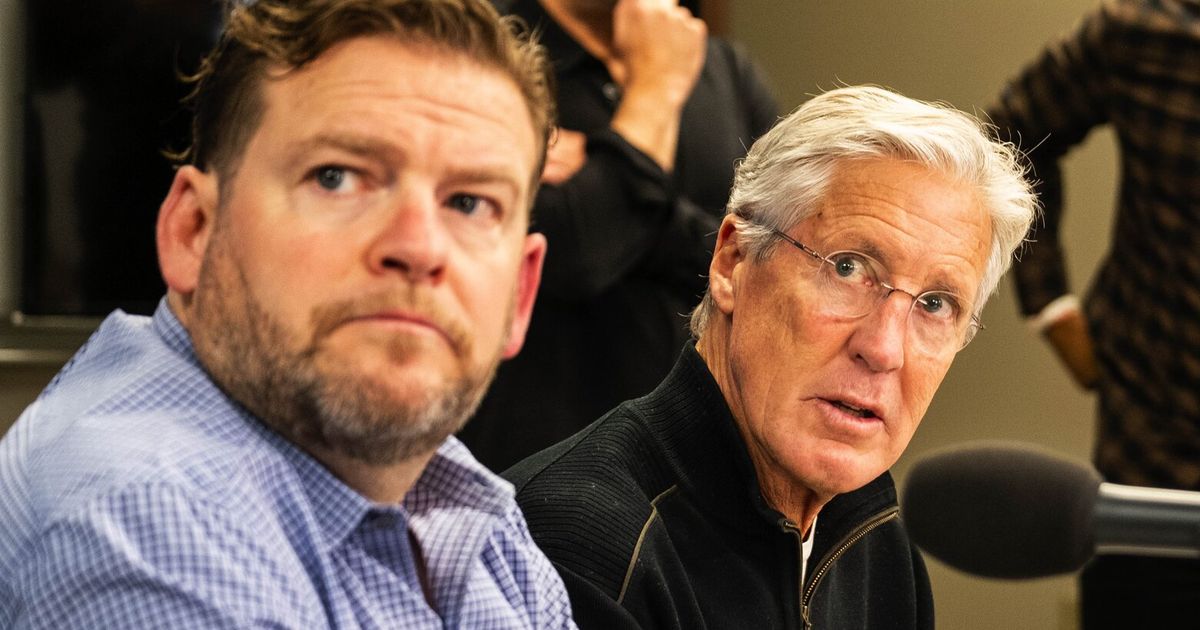
We have become so conditioned to the start of NFL free agency being a spectator sport for the Seahawks that the news of an actual significant signing Monday seemed like a prank.
Surely it must have been one of those fake Twitter accounts that crop up at times like this, authored by someone named Cob Bondotta. Because that’s not how general manager John Schneider and coach Pete Carroll operate.
They preferred to sit back and let their competition fight among themselves in the early feeding frenzy, not unlike when appliance-store doors used to open on Black Friday and customers would tussle over the one $50 deluxe television set. As Carroll has said multiple times over the years, the first day is when you tend to make the kinds of mistakes that haunt a team for years.
But desperate times call for desperate measures, as either Hippocrates or Bill Walsh once said. For Seattle, “desperation” is defined as a defense that last year ranked as one of the worst in the NFL, especially up front. And so there indeed were the Seahawks on Monday, elbows flying, joining the fray to sign defensive lineman Dre’Mont Jones, formerly of the Denver Broncos. They followed up Tuesday by bringing back defensive tackle Jarran Reed, their second-round draft pick in 2016, on a two-year deal.
For the Seahawks, it’s a great, albeit startling, start to the Great Defensive Rebuild Project. Jones resembles (at least in their dreams) nothing less than the second coming of Michael Bennett, a versatile force who can work both inside and outside with equal aplomb. It was the signing of Bennett and Cliff Avril in the free agency period of 2013 — Avril on the second day, Bennett on the third for the bargain-basement cost of 1 year, $5 million — that put the finishing touches on a historic defense that would win a Lombardi Trophy that very season.
That’s not to suggest the Seahawks are poised on the brink of another championship. But that’s what they’re trying to build toward. The signing of Jones, like the one last week of quarterback Geno Smith (insert “Alias Smith and Jones” joke for the olds), opens a realm of possibilities for the Seahawks as they try to move from fringe playoff team to legitimate contender.
There is definitely an interconnectedness to the two deals. By signing Geno Smith to a contract that became increasingly more team-friendly with each revelation of its terms, it helped free the cap space for the Seahawks to dive into the deep end of free agency. And with quarterback and defensive force up front now dealt with from their “to-do” list, it frees Carroll and Schneider to attack the NFL draft with a true “best player available” approach.
If there’s a quarterback they think is a can’t-miss prospect to eventually succeed Smith, they can take him, because Jones — just 26 — is theoretically that “pillar guy” on defense they’ve been seeking. This is a draft that experts rate as heavy with edge-rushing talent compared with interior lineman, so the Seahawks can realistically hope to get an impact rusher with their second first-round pick, No. 20 overall. Or, if an edge rusher such as Will Anderson or Tyree Wilson is simply too irresistible to bypass at No. 5, you can take one and have the remade defensive line they covet.
Traditionally, the Seahawks have used free agency primarily to re-sign their players and find depth pieces. At least, that has been the strategy of the current regime since 2011, their second year in charge, when they came out blazing on the first day of free agency with wide receiver Sidney Rice (one year removed from a 1,300-yard Pro Bowl season) and Zach Miller, the top pass-catching tight end on the market, getting inked.
The fact that neither quite lived up to expectations may have been a cautionary tale, but that took a few years to reveal itself. Those signings came in the building phase of Schneider and Carroll’s early tenure, coming off back-to-back 7-9 seasons. By the next year, however, the Seahawks were ascending to the stratosphere. That’s when they molded their strategy of sitting out the frenetic early phase of “legal tampering,” to use the oxymoron of choice. And it worked for them, by and large.
What changed this year? Well, for one thing, poor drafting left holes for which free agency was the necessary antidote. By all rights, someone such as, say, L.J. Collier would have established himself on the defensive front and be right in the wheelhouse of his prime. But Collier, the Seahawks’ first-round draft choice in 2019, has been a major disappointment, with just three sacks to show for his four seasons with Seattle.
Similarly, third-round linebacker Cody Barton failed to establish himself to the extent that the Seahawks didn’t intervene with a serious counter-offer when the Washington Commanders swooped in Monday with a one-year, $3.5 million contract. And now the Seahawks are heavily in the market for a linebacker either via free agency or the draft. Can you say, “Bobby Wagner?”
Everyone knew the Seahawks had to revamp their defense to break out of their rut of being a one-off playoff team. The Times’ Bob Condotta reported that they went hard Monday after not just Jones, but also Zach Allen, the ex-Cardinals defensive end who instead signed a three-year deal with Denver.
The fact that the Seahawks were so heavily involved on Day 1, giving Jones the biggest contract they’ve ever bestowed upon an outside free agent (three years worth up to $51.53 million), shows how seriously they are taking their defense rebuild.
But it’s only just begun.